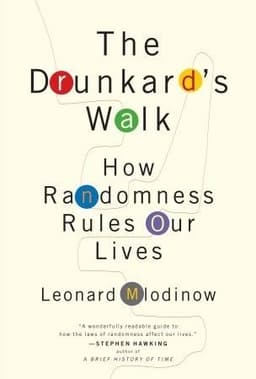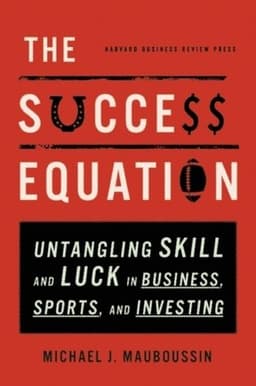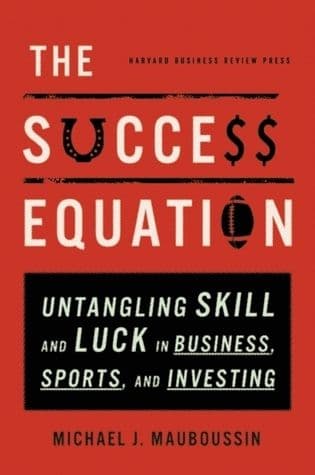
The Drunkard's Walk Book Summary
How Randomness Rules Our Lives
Book by Leonard Mlodinow
Summary
"The Drunkard's Walk" reveals how randomness and chance play a far greater role in our lives than we typically realize, challenging our perceptions of success, decision-making, and the patterns we think we see in the world around us.
Sign in to rate
Average Rating: 5
The Illusion of Patterns in Hollywood
The film industry often appears to follow patterns, with certain actors, directors, or genres seeming to guarantee success. However, this perception is largely an illusion. The author discusses how even highly successful studio executives like Sherry Lansing can have their reputations rise and fall based on what is essentially random fluctuation in movie performance.
For instance, Lansing was praised for her ability to turn conventional stories into hits when Paramount was doing well, but later criticized for the same approach when the studio had a few underperforming years. This demonstrates how we tend to create narratives to explain what are often just random outcomes.
Section: 1, Chapter: 1
The Misinterpretation of Baseball Statistics
The author analyzes Roger Maris's record-breaking 61 home run season in 1961. While this feat was seen as extraordinary, statistical analysis shows it was not as improbable as it seemed. Given the number of skilled players over decades of baseball history, there was actually about a 50% chance that someone would have such an exceptional season by chance alone. This example illustrates how we often underestimate the likelihood of rare events occurring naturally in large samples, leading us to seek special explanations for what may be random occurrences.
Section: 1, Chapter: 1
The Role of Randomness in Success
Random factors play a much larger role in success than we typically acknowledge. Using examples from Hollywood, sports, and business, the author demonstrates how unpredictable events and timing often contribute significantly to outcomes. This doesn't mean skill and effort are irrelevant, but rather that their relationship to success is less direct than commonly believed. Understanding this can lead to a more realistic view of both success and failure in various fields.
Section: 1, Chapter: 1
The Prosecutor's Fallacy
The prosecutor's fallacy is a misapplication of conditional probability often seen in legal settings. It involves confusing the probability of evidence given innocence with the probability of innocence given evidence. For example, in the Collins case, prosecutors argued that the low probability of a couple matching the description of the perpetrators meant the defendants were likely guilty.
However, this ignores the base rate of innocent couples who might also match the description. This fallacy can lead to significant overestimation of guilt based on seemingly convincing statistical arguments.
Section: 1, Chapter: 2
Base Rate Neglect in Medical Diagnosis
When interpreting medical test results, it's crucial to consider the base rate of the condition being tested for, not just the accuracy of the test. The author gives an example of HIV testing, where a positive result on a 99.9% accurate test doesn't necessarily mean a 99.9% chance of having HIV. If the disease is rare in the population being tested, the chance of a false positive can be much higher than intuition suggests. This highlights the importance of considering all relevant probabilities, not just the most obvious ones, when making judgments under uncertainty.
Section: 1, Chapter: 2
The Monty Hall Problem
The Monty Hall problem, based on a game show scenario, demonstrates how counterintuitive probability can be. Contestants choose one of three doors, behind one of which is a prize. After the initial choice, the host opens a non-winning door and offers the contestant a chance to switch.
Counterintuitively, switching doubles the chances of winning from 1/3 to 2/3. This is because the host's action provides new information that changes the probabilities. The problem famously stumped many mathematicians and illustrates how our intuitions about chance can often be wrong.
Section: 1, Chapter: 3
Pascal's Contributions to Probability Theory
Blaise Pascal made significant contributions to probability theory in the 17th century. His work on the "problem of points" - how to fairly divide stakes in an interrupted game of chance - led to important developments in combinatorics and probability calculation. Pascal's triangle, a tool for calculating combinations, became a fundamental concept in probability theory. His work also laid the groundwork for expected value theory, which he applied to questions of faith in his famous "Pascal's Wager".
Section: 1, Chapter: 3
The Law of Large Numbers
The law of large numbers, formalized by Jakob Bernoulli, states that as the number of trials of a random process increases, the average of the results will tend to converge on the expected value.
This principle is crucial for understanding how probability manifests in the real world. For example, while a small number of coin flips might deviate significantly from 50% heads, a large number of flips will tend very close to this expected ratio. This law underpins many statistical methods and helps explain why large samples are generally more reliable than small ones.
Section: 1, Chapter: 3
The Concept of Mathematical Expectation
Pascal introduced the concept of mathematical expectation, which calculates the average outcome of a random process if it were repeated many times. This idea is crucial in decision theory and game theory. Pascal applied it to his famous "wager" about belief in God, arguing that the potential infinite gain of believing outweighs any finite cost. In modern times, expectation is used in various fields, from insurance to gambling, to quantify the likely outcome of uncertain events. Understanding expectation can help in making rational decisions under uncertainty.
Section: 1, Chapter: 4
The Surprising Birthday Problem
The birthday problem illustrates the counterintuitive nature of probability. It asks how many people need to be in a room for there to be a 50% chance that at least two share a birthday. The surprising answer is just 23 people, far fewer than most people intuitively guess. This unexpected result arises because we're not looking for a specific shared birthday, but any match among the group.
The calculation involves considering the probability of no matches and subtracting from 1. This problem has practical applications in fields like cryptography, where it's used to understand collision probabilities in hashing algorithms. It serves as a powerful reminder that our intuition about probability can often be misleading, emphasizing the importance of rigorous mathematical analysis in probability problems.
Section: 1, Chapter: 4
Avoiding the Gambler's Fallacy
The Gambler's Fallacy is the mistaken belief that if a random event occurs more frequently than normal during a given period, it will occur less frequently in the future (or vice versa). For example, if a roulette wheel has landed on black several times in a row, some might believe red is "due". This is a misunderstanding of random processes - each spin is independent and has the same probability regardless of past results. To avoid this fallacy:
- Remember that each trial is a new, independent event
- Focus on the unchanging probabilities, not recent outcomes
- Be skeptical of "hot streaks" or "cold streaks" in truly random events Recognizing this fallacy can prevent poor decision-making in gambling and other areas involving randomness.
Section: 1, Chapter: 5
Benford's Law: Detecting Patterns in Randomness
Benford's Law describes the frequency distribution of leading digits in many real-world sets of numerical data. Counterintuitively, in many naturally occurring collections of numbers, 1 appears as the leading significant digit about 30% of the time, while 9 appears only about 5% of the time. This principle has been applied to detect fraud in financial statements and other datasets where humans have fabricated numbers.
For instance, if the frequency of leading digits in a company's financial reports deviates significantly from Benford's Law, it might indicate manipulation of the numbers. However, it's important to note that not all datasets follow this law, such as assigned numbers like phone numbers or zip codes.
Understanding Benford's Law illustrates how seemingly random data can follow predictable patterns, and how these patterns can be leveraged for practical applications in fraud detection and data validation.
Section: 1, Chapter: 5
Bayes' Theorem: Updating Beliefs with Evidence
Bayes' Theorem, developed by Thomas Bayes, is a fundamental principle for updating probabilities based on new evidence.
The theorem is expressed as P(A|B) = P(B|A) * P(A) / P(B), where P(A|B) is the probability of A given B, P(B|A) is the probability of B given A, P(A) is the prior probability of A, and P(B) is the total probability of B.
This formula allows us to calculate how the probability of an event changes based on new information. Bayes' Theorem is crucial in many real-world scenarios, from medical diagnosis to legal reasoning. For example, it explains why a positive result on a medical test doesn't necessarily mean a high probability of having the disease, especially if the disease is rare in the population. Understanding and applying Bayes' Theorem can lead to more accurate interpretations of probabilistic information in various fields.
Section: 1, Chapter: 6
The Base Rate Fallacy in Medicine
The base rate fallacy occurs when people ignore the underlying probability of an event (the base rate) when judging the likelihood of a specific occurrence. In medicine, this can lead to misinterpretation of test results. For instance, a test with 99% accuracy might seem definitive, but if the disease is very rare (say, 1 in 10,000 people have it), most positive results will actually be false positives. To avoid this fallacy:
- Always consider the prevalence of the condition being tested for
- Remember that test accuracy alone is not enough to determine the probability of having a condition
- Use Bayes' Theorem to calculate the true probability of a condition given a positive test result Being aware of this can lead to more informed medical decision-making and reduced unnecessary anxiety over test results.
Section: 1, Chapter: 6
The Prosecutor's Fallacy in Legal Reasoning
The prosecutor's fallacy is a misapplication of conditional probability often seen in legal settings. It involves confusing the probability of evidence given innocence with the probability of innocence given evidence. A famous example is the Sally Clark case, where Clark was wrongly convicted of murdering her two children who had died of Sudden Infant Death Syndrome (SIDS).
The prosecution argued that the chance of two SIDS deaths in one family was 1 in 73 million, implying guilt. However, this was the probability of two SIDS deaths given innocence, not the probability of innocence given two deaths. This fallacy led to a wrongful conviction, later overturned. The case demonstrates the dangers of misapplying probability in high-stakes situations and underscores the need for careful, mathematically sound reasoning in legal contexts. Understanding this fallacy can help jurors, lawyers, and judges better evaluate probabilistic evidence in court.
Section: 1, Chapter: 6
The Normal Distribution: Nature's Favorite Pattern
The normal distribution, also known as the bell curve, is a fundamental concept in statistics. It describes a symmetrical, bell-shaped distribution of data where most observations cluster around the mean, with fewer observations towards the extremes. Key properties:
- About 68% of observations fall within one standard deviation of the mean
- About 95% fall within two standard deviations
- About 99.7% fall within three standard deviations
This distribution is ubiquitous in nature and human affairs, from human height to measurement errors in scientific experiments. Understanding the normal distribution is crucial for interpreting data and making inferences about populations from samples.
Section: 1, Chapter: 7
The Illusion of Precision in Measurements
Measurements, whether in science, business, or everyday life, often carry an illusion of precision that belies their inherent uncertainty. The chapter discusses how even seemingly precise measurements, like SAT scores or unemployment rates, have significant margins of error. For instance, a student's SAT score can vary by dozens of points if they retake the test, not due to changes in ability but due to random factors.
Similarly, small changes in unemployment rates often reported as significant may be within the margin of error. This illusion of precision can lead to misinterpretation of data and poor decision-making. Recognizing the inherent variability in measurements is crucial for making more accurate assessments and avoiding overconfidence in data interpretation.
Section: 1, Chapter: 7
The Subjective Nature of Wine Ratings
The chapter uses wine ratings as an example of how subjective judgments can be mistaken for objective measurements. Despite the apparent precision of 100-point wine rating scales, studies have shown that wine experts often cannot consistently rate the same wine when presented blindly on different occasions. Factors such as the power of suggestion, context, and expectation significantly influence taste perceptions.
For instance, when the same wine was presented in differently priced bottles, tasters consistently rated the "expensive" wine higher. This example illustrates how our perceptions and judgments can be influenced by factors unrelated to the quality we're trying to measure, and how we often attribute more meaning to numerical ratings than is warranted.
Section: 1, Chapter: 7
Statistical Regularities in Large Numbers
This chapter explores how large numbers can reveal surprising regularities in seemingly chaotic systems. For instance, while individual car accidents may seem random, the total number of accidents and fatalities in a country often remains remarkably stable from year to year. Similarly, suicide rates, crime rates, and even the number of wrongly addressed letters tend to show consistent patterns when viewed on a large scale.
This phenomenon, first noted by statisticians like Quételet in the 19th century, led to the development of social physics and the idea that human behavior, when aggregated, follows predictable patterns. Understanding these regularities can be valuable for policy-making, urban planning, and predicting societal trends, even if individual events remain unpredictable.
Section: 1, Chapter: 8
Galton's Contributions to Statistics
Francis Galton, a cousin of Charles Darwin, made significant contributions to the field of statistics. His key contributions include:
- Regression to the mean: The observation that extreme characteristics in parents tend to be less extreme in their children
- Correlation: A measure of the strength of association between two variables
- The concept of standard deviation as a measure of variability
Galton's work laid the foundation for many modern statistical techniques and highlighted the importance of understanding variation in populations. His ideas about regression to the mean, in particular, have important implications for understanding phenomena in fields ranging from genetics to sports performance.
Section: 1, Chapter: 8
The Birth of Brownian Motion
The chapter discusses the discovery and explanation of Brownian motion, the random movement of particles suspended in a fluid. Robert Brown first observed this phenomenon in 1827 when studying pollen grains in water. Initially mistaken for a sign of life, it was later shown to occur with any small particles.
The true explanation came from Albert Einstein in 1905, who demonstrated that the motion was caused by the bombardment of the particles by invisible molecules in the fluid. This discovery was pivotal in confirming the existence of atoms and molecules, and it exemplifies how apparent randomness at one level (the motion of the particle) can be explained by underlying order at another level (the behavior of molecules). Brownian motion has since become a fundamental concept in fields ranging from physics to finance.
Section: 1, Chapter: 8
The Hot Hand Fallacy in Sports and Finance
The hot hand fallacy is the belief that a person who has experienced success with a random event has a greater chance of further success in additional attempts. This fallacy is common in sports and finance. In basketball, for instance, players and fans often believe that a player who has made several shots in a row is more likely to make the next shot.
However, statistical analyses have shown that successive shots are independent events. Similarly, in finance, investors often believe that fund managers who have performed well in the past are likely to continue outperforming, despite evidence that past performance does not predict future results. Understanding this fallacy can help in making more rational decisions in sports strategy, financial investments, and other areas where we might mistakenly see patterns in random sequences.
Section: 1, Chapter: 9
The Power of Expectations in Perception
Our expectations powerfully shape our perceptions, often leading us to see patterns where none exist. The chapter discusses several psychological experiments demonstrating this effect. For example, in wine tasting experiments, experts' judgments were significantly influenced by the perceived price or prestige of the wine, even when they were actually tasting the same wine.
Similarly, in medical contexts, the expectation of a certain diagnosis can lead doctors to interpret ambiguous symptoms in line with that expectation. This tendency to see what we expect to see can lead to confirmation bias, where we seek out information that confirms our pre-existing beliefs and ignore contradictory evidence. Recognizing the role of expectations in shaping our perceptions is crucial for more objective decision-making and analysis.
Section: 1, Chapter: 9
The Clustering Illusion
The clustering illusion is the tendency to see patterns in random distributions. A famous example is the V-2 rocket strikes on London during World War II. Citizens and officials noticed apparent clusters in the strike locations, leading to theories about German precision or spies. However, statistical analysis showed that the distribution of strikes was consistent with a random pattern.
This illusion also appears in other contexts, such as cancer clusters or hot streaks in gambling. The chapter explains that humans are predisposed to see patterns, even in random data, as an evolutionary adaptation. However, this can lead to false conclusions. Understanding this illusion is important for correctly interpreting data in fields ranging from epidemiology to financial market analysis, where distinguishing between genuine patterns and random clustering is crucial.
Section: 1, Chapter: 9
The Role of Chance in Success
This chapter argues that random events play a much larger role in success than is commonly acknowledged. Using examples from various fields, including entertainment, business, and science, the author demonstrates how unpredictable factors often contribute significantly to outcomes.
For instance, many successful authors or entrepreneurs faced numerous rejections before their breakthrough, suggesting that timing and chance played a crucial role.
Mlodinow doesn't argue that skill and effort are irrelevant, but rather that their relationship to success is less direct than commonly believed. Understanding the significant role of randomness can lead to a more realistic view of both success and failure, potentially reducing unwarranted attribution of success solely to skill or failure solely to lack of ability.
Section: 1, Chapter: 10
The Drunkard's Walk as a Metaphor for Life
The 'drunkard's walk' is a mathematical concept describing random motion, like that of a drunk staggering home. The chapter uses this as a metaphor for life paths, suggesting that our careers and personal lives often follow similarly unpredictable trajectories. Key aspects of this metaphor include:
- Small, random events can have large, unforeseen consequences
- The path is only clear in hindsight; predicting it in advance is nearly impossible
- Success often comes from persistence rather than a predetermined path
This framework encourages a perspective that embraces uncertainty and resilience in the face of setbacks, recognizing that random factors play a significant role in shaping our lives.
Section: 1, Chapter: 10
Hindsight Bias and the Illusion of Inevitability
The chapter discusses how events often seem inevitable in hindsight, even when they were highly unpredictable at the time. A striking example is the attack on Pearl Harbor. After the fact, numerous 'warning signs' were identified, leading to the belief that the attack should have been anticipated. However, at the time, these signs were lost in a sea of other information and potential threats.
This illustrates hindsight bias, our tendency to believe that we would have predicted an outcome that has already occurred. This bias can lead to unfair judgments of decision-makers and a false sense of predictability in complex situations. Recognizing this bias is crucial in fields like history, business strategy, and risk assessment, where accurate evaluation of past decisions and events is important.
Section: 1, Chapter: 10
Related Content


Subliminal Book Summary
Leonard Mlodinow
Subliminal: How Your Unconscious Mind Rules Your Behavior reveals the powerful influence of the unconscious mind on our thoughts, feelings, and actions - from how we perceive the world, to how we interact with others, make decisions, and understand ourselves.
Subliminal: How Your Unconscious Mind Rules Your Behavior reveals the powerful influence of the unconscious mind on our thoughts, feelings, and actions - from how we perceive the world, to how we interact with others, make decisions, and understand ourselves.
Psychology
Neuroscience
Business


The Success Equation Book Summary
Michael Mauboussin
The Success Equation is a comprehensive guide to understanding the relative roles of skill and luck in shaping outcomes, offering practical insights and tools for improving decision-making, performance, and predictions in a wide range of domains, from sports and business to education and investing.
The Success Equation is a comprehensive guide to understanding the relative roles of skill and luck in shaping outcomes, offering practical insights and tools for improving decision-making, performance, and predictions in a wide range of domains, from sports and business to education and investing.
Sports
Management
Psychology
Decision Making

